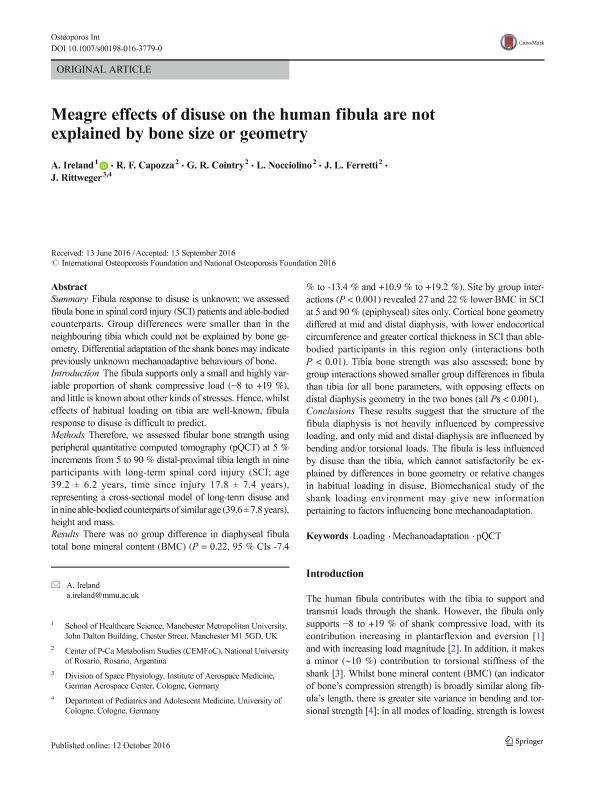Mostrar el registro sencillo del ítem
dc.contributor.author
Ireland, Alex

dc.contributor.author
Capozza, Ricardo Francisco

dc.contributor.author
Cointry, Gustavo Roberto

dc.contributor.author
Nocciolino, Laura Marcela

dc.contributor.author
Ferretti, Jose Luis

dc.contributor.author
Rittweger, J.
dc.date.available
2019-06-18T17:59:16Z
dc.date.issued
2017-02
dc.identifier.citation
Ireland, Alex; Capozza, Ricardo Francisco; Cointry, Gustavo Roberto; Nocciolino, Laura Marcela; Ferretti, Jose Luis; et al.; Meagre effects of disuse on the human fibula are not explained by bone size or geometry; Springer London Ltd; Osteoporosis International; 28; 2; 2-2017; 633-641
dc.identifier.issn
0937-941X
dc.identifier.uri
http://hdl.handle.net/11336/78433
dc.description.abstract
Summary: Fibula response to disuse is unknown; we assessed fibula bone in spinal cord injury (SCI) patients and able-bodied counterparts. Group differences were smaller than in the neighbouring tibia which could not be explained by bone geometry. Differential adaptation of the shank bones may indicate previously unknown mechanoadaptive behaviours of bone. Introduction: The fibula supports only a small and highly variable proportion of shank compressive load (−8 to +19 %), and little is known about other kinds of stresses. Hence, whilst effects of habitual loading on tibia are well-known, fibula response to disuse is difficult to predict. Methods: Therefore, we assessed fibular bone strength using peripheral quantitative computed tomography (pQCT) at 5 % increments from 5 to 90 % distal-proximal tibia length in nine participants with long-term spinal cord injury (SCI; age 39.2 ± 6.2 years, time since injury 17.8 ± 7.4 years), representing a cross-sectional model of long-term disuse and in nine able-bodied counterparts of similar age (39.6 ± 7.8 years), height and mass. Results: There was no group difference in diaphyseal fibula total bone mineral content (BMC) (P = 0.22, 95 % CIs -7.4 % to -13.4 % and +10.9 % to +19.2 %). Site by group interactions (P < 0.001) revealed 27 and 22 % lower BMC in SCI at 5 and 90 % (epiphyseal) sites only. Cortical bone geometry differed at mid and distal diaphysis, with lower endocortical circumference and greater cortical thickness in SCI than able-bodied participants in this region only (interactions both P < 0.01). Tibia bone strength was also assessed; bone by group interactions showed smaller group differences in fibula than tibia for all bone parameters, with opposing effects on distal diaphysis geometry in the two bones (all Ps < 0.001). Conclusions: These results suggest that the structure of the fibula diaphysis is not heavily influenced by compressive loading, and only mid and distal diaphysis are influenced by bending and/or torsional loads. The fibula is less influenced by disuse than the tibia, which cannot satisfactorily be explained by differences in bone geometry or relative changes in habitual loading in disuse. Biomechanical study of the shank loading environment may give new information pertaining to factors influencing bone mechanoadaptation.
dc.format
application/pdf
dc.language.iso
eng
dc.publisher
Springer London Ltd

dc.rights
info:eu-repo/semantics/openAccess
dc.rights.uri
https://creativecommons.org/licenses/by-nc-sa/2.5/ar/
dc.subject
Loading
dc.subject
Mechanoadaptation
dc.subject
Pqct
dc.subject.classification
Otras Ciencias de la Salud

dc.subject.classification
Ciencias de la Salud

dc.subject.classification
CIENCIAS MÉDICAS Y DE LA SALUD

dc.title
Meagre effects of disuse on the human fibula are not explained by bone size or geometry
dc.type
info:eu-repo/semantics/article
dc.type
info:ar-repo/semantics/artículo
dc.type
info:eu-repo/semantics/publishedVersion
dc.date.updated
2018-12-19T13:20:54Z
dc.identifier.eissn
1433-2965
dc.journal.volume
28
dc.journal.number
2
dc.journal.pagination
633-641
dc.journal.pais
Reino Unido

dc.journal.ciudad
Londres
dc.description.fil
Fil: Ireland, Alex. Manchester Metropolitan University; Reino Unido
dc.description.fil
Fil: Capozza, Ricardo Francisco. Consejo Nacional de Investigaciones Científicas y Técnicas. Centro Científico Tecnológico Conicet - Rosario; Argentina. Universidad Nacional de Rosario. Facultad de Ciencias Médicas. Centro de Estudios de Metabolismo Fosfocálcico; Argentina
dc.description.fil
Fil: Cointry, Gustavo Roberto. Universidad Nacional de Rosario. Facultad de Ciencias Médicas. Centro de Estudios de Metabolismo Fosfocálcico; Argentina. Consejo Nacional de Investigaciones Científicas y Técnicas. Centro Científico Tecnológico Conicet - Rosario; Argentina
dc.description.fil
Fil: Nocciolino, Laura Marcela. Universidad Nacional de Rosario. Facultad de Ciencias Médicas. Centro de Estudios de Metabolismo Fosfocálcico; Argentina. Consejo Nacional de Investigaciones Científicas y Técnicas. Centro Científico Tecnológico Conicet - Rosario; Argentina
dc.description.fil
Fil: Ferretti, Jose Luis. Universidad Nacional de Rosario. Facultad de Ciencias Médicas. Centro de Estudios de Metabolismo Fosfocálcico; Argentina. Consejo Nacional de Investigaciones Científicas y Técnicas. Centro Científico Tecnológico Conicet - Rosario; Argentina
dc.description.fil
Fil: Rittweger, J.. Universitat zu Köln; Alemania. Deutsches Zentrum für Luft- und Raumfahrt; Alemania
dc.journal.title
Osteoporosis International

dc.relation.alternativeid
info:eu-repo/semantics/altIdentifier/url/https://link.springer.com/article/10.1007/s00198-016-3779-0
dc.relation.alternativeid
info:eu-repo/semantics/altIdentifier/doi/https://doi.org/10.1007/s00198-016-3779-0
Archivos asociados
